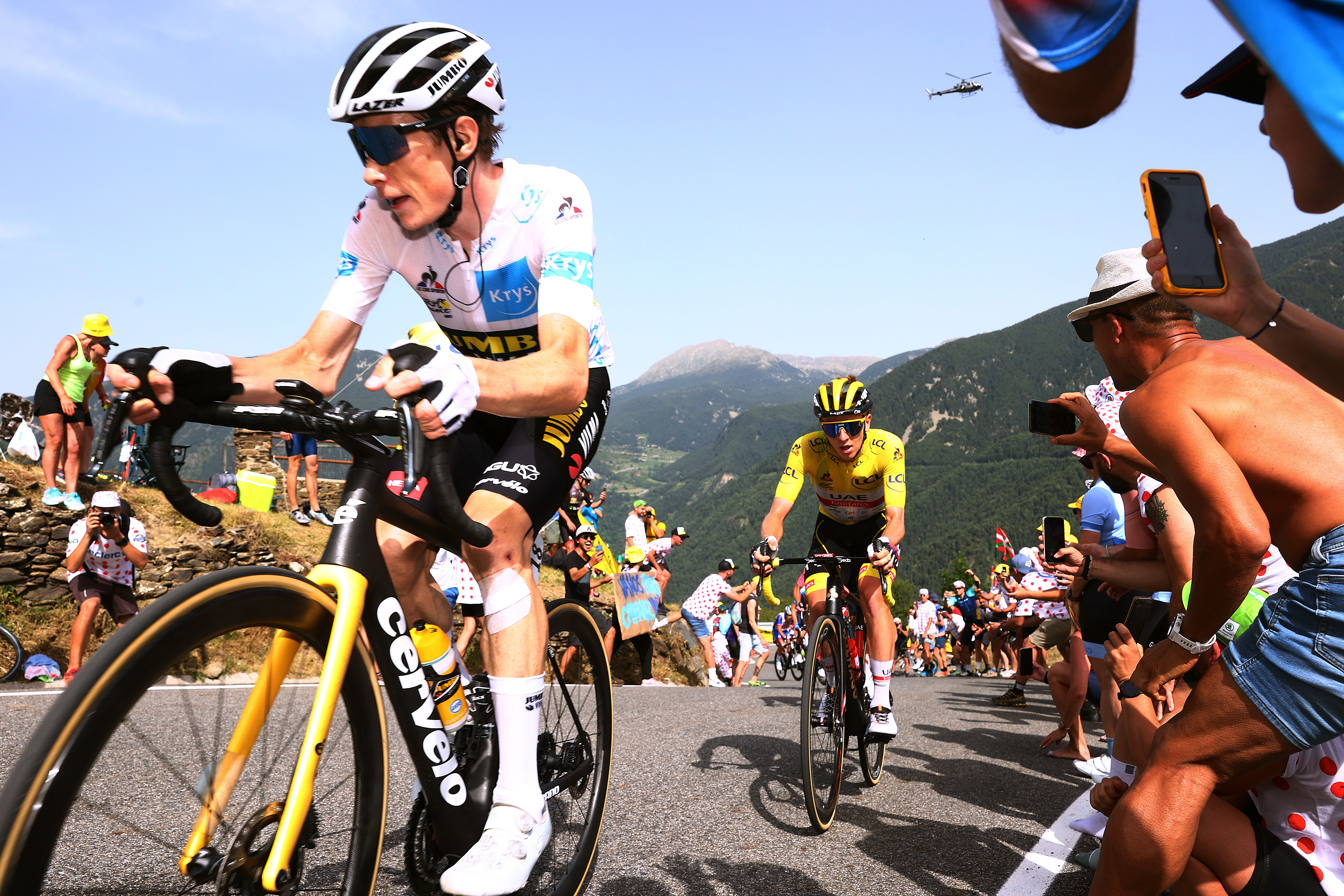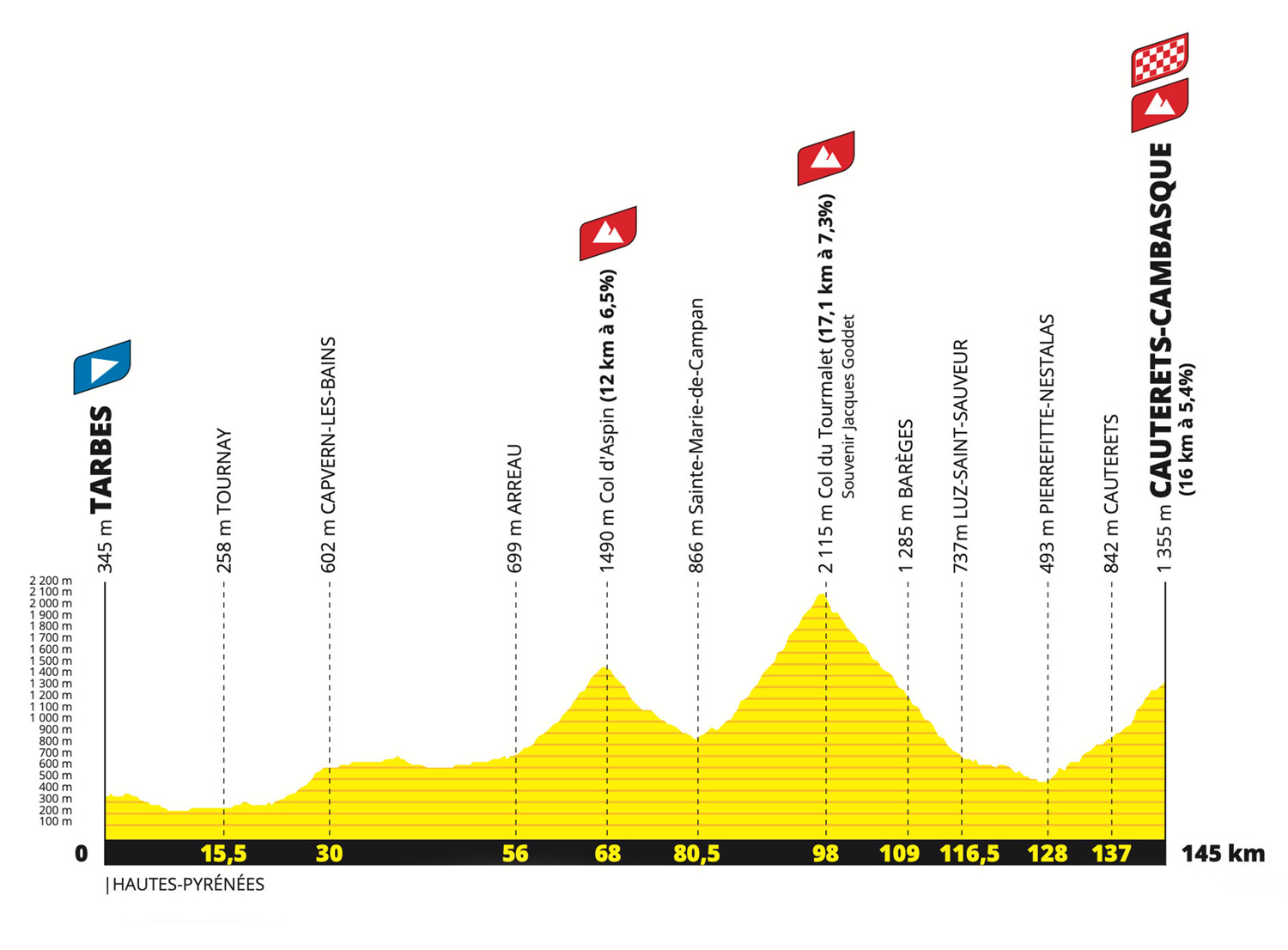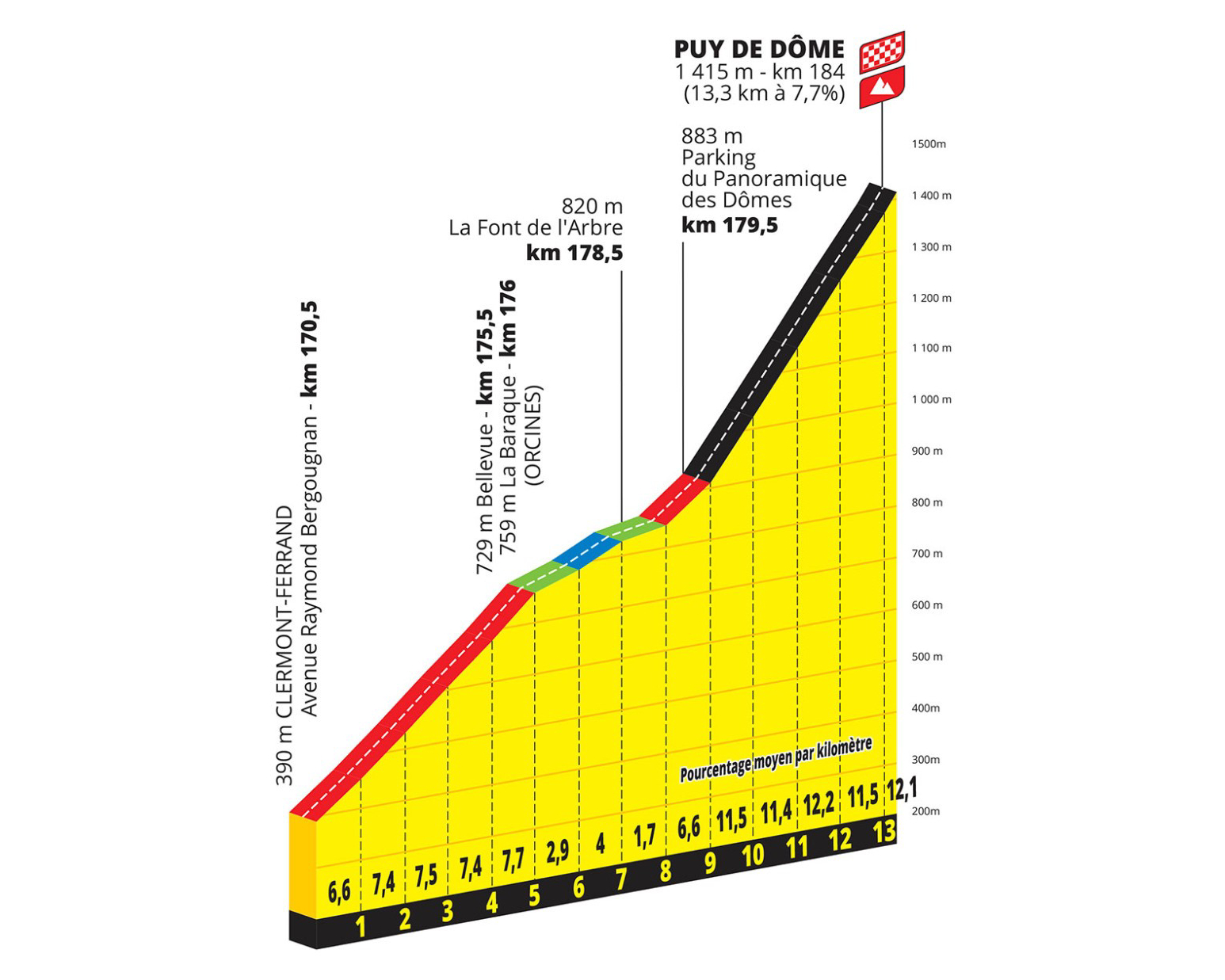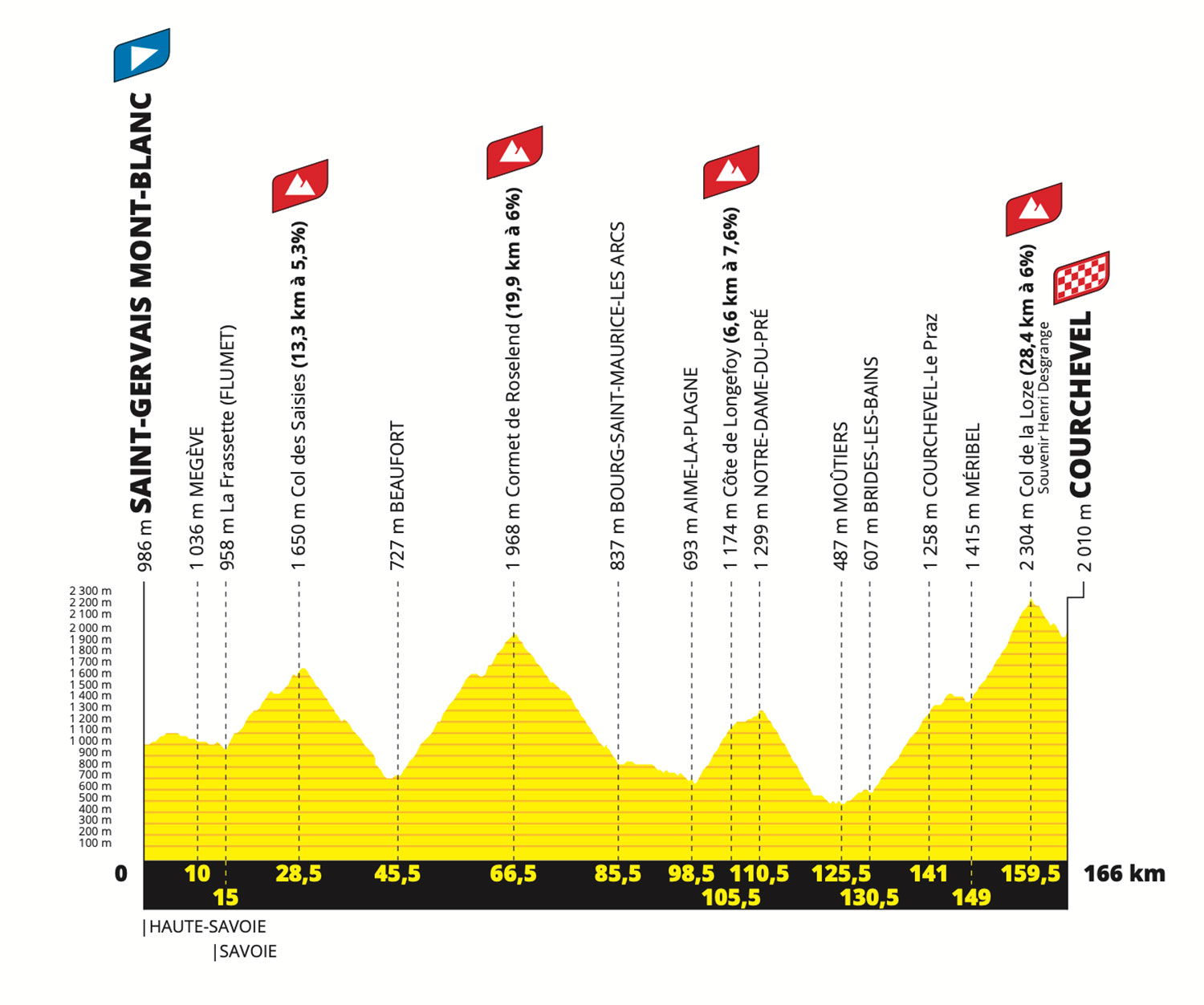Tour de France 2023 - Five key stages
From the Pyrenees to Alsace, the days that could decide the race

Picking out five key stages from a Tour de France route has rarely been this difficult. With five mountain ranges – the Pyrenees, Massif Central, Jura, Alps and Vosges – all visited across the route of the 2023 Tour, there are potentially pivotal days at just about every turn next July.
What’s more, in this breathless modern era, even seemingly milder days have the potential to catch fire. Witness Wout van Aert’s one-man show of force on the road to Longwy in 2022, for instance, or Thibaut Pinot and Julian Alaphilippe’s two-up effort en route to Saint-Étienne in 2019.
And yet, when the lights go up in the Palais des Congrès every October, some stages stand out more than others. In 2023, mind, there were at least eight or nine stages that caught the eye, and some particularly arduous days have been cast aside from this (very) short list, including the tough summit finish on the Grand Colombier on stage 13 and the passage over the Col de Joux Plane a day later.
At this early juncture, here are five stages that whet the appetite ahead of the big show in July.
Stage 6: Tarbes - Cauterets-Cambasque, 145km

When the Grand Départ last took place in the Basque Country in 1992, the Tour paid only a most perfunctory visit to the Pyrenees on its passage back into France. Javier Murguialday won in Pau after skirting the mountains on stage 3, while his breakaway companion, a youngster called Richard Virenque, announced himself to Le Grand Public by taking temporary hold of the yellow jersey. The GC men, including Miguel Indurain, preferred to keep their powder dry for the challenges ahead, namely the 63.5km team time trial two days later and the 65km individual time trial in Luxembourg at the end of the opening week.
Unlike in the Jean-Marie Leblanc era, there is no respite for overall contenders in the modern Tour. The men with designs on yellow in Paris will again be forced into action early and often in 2023. After a hilly opening stanza in the Basque Country, the Tour swings into the Pyrenees for two stages that could make a deep early impression on the general classification. The first, on stage 5, features the short but stiff Col de Marie Blanque ahead of the finish in Laruns, but the second to Cauterets is the main event.
Though just 145km in length, stage 6 from Tarbes features three mountain passes. First up is the Col d’Aspin (12km at 6.5%) after 68km, followed by the mighty Col du Tourmalet (17.1km at 7.3%), which returns to the route after being overlooked in 2022. The long drop to Luz Saint Sauveur notionally offers a chance for the race to regroup, but anybody who went too deep on the Tourmalet might pay for that effort on the final haul to Cauterets. The 16km climb has an average gradient of just 5.4%, but statistics can be deceptive on a day such as this. A Pyrenean stage of this magnitude this early in the Tour is certain to create ructions.
The latest race content, interviews, features, reviews and expert buying guides, direct to your inbox!
Stage 9: Saint-Léonard-de-Noblat - Puy de Dôme, 184km

In the summer of 2001, the Luxembourg Gardens doubled as the site of an outdoor exhibition of the greatest photographs ever to grace the pages of L’Équipe. The railings along the perimeter were adorned with striking images, from fencing to football, from Alain Prost to Zinedine Zidane. But, like the Mona Lisa in the Louvre, one picture attracted more footfall than any other on those balmy evenings: Jacques Anquetil and Raymond Poulidor, elbow to elbow on the Puy de Dôme, locked in combat for the 1964 Tour.
It’s likely that more words have been written about that Tour than any other, and plenty more will follow over the next eight months. The Puy de Dôme is one of the Tour’s holy sites but it has not featured on the route since 1988 due to the construction of a panoramic railway up the dormant volcano that overlooks Clermont Ferrand. Cycling is strictly prohibited on the narrow road alongside the railway, but on joining ASO in 2004, Christian Prudhomme made returning to Puy de Dôme an objective. It even featured on his initial route plans in 2012, but it took until 2023 before the logistics could be thrashed out.
Unlike that indelible afternoon in 1964, when half of France seemed to have congregated on the mountainside, no spectators will be permitted on the final 4km of the climb next July, but the televised spectacle should be no less enthralling. Clermont native Raphaël Geminiani knows the climb better than anyone. He raced up on its first appearance in the Tour in 1952, when Fausto Coppi won at the summit, and he was Anquetil’s directeur sportif a dozen years later. “There’s the Alpe d'Huez, but nothing can compare to the Puy de Dôme. It’s a straight line and it just goes straight up...” Geminiani told France 3. “It is very difficult.”
In 2023, the Puy de Dôme comes at the end of a rugged stage through the Auvergne. Although there are no extreme ascents on the agenda beforehand, the terrain is latently demanding, with some 3,600m of total climbing. The day’s highlight, of course, comes on the vicious climb to the finish. The full ascent from Clermont is 13km in length at an average of 7.7%, but the key difficulty comes in that steep and straight final 4km, where the gradient never drops below 11%. Sweltering heat is often a factor in this corner of the world in July.
The final stage before the Tour’s first rest day could be pivotal.
Stage 16: Passy – Combloux, 22km (Individual time trial)

With such a preponderance of mountain stages, it’s easy to overlook the significance of the lone time trial on this Tour route. And yet, in modern Grand Tours, even the smallest portion of time trialling kilometres can add up to a hell of a difference over three weeks. The 2017 Tour was a case in point, where Romain Bardet had Chris Froome’s measure in the mountains but still finished the race in third place, his 2:20 deficit essentially amassed in just 36km of time trialling.
The controlled racing of 2017, of course, already feels an eon removed from the remorseless chaos that seems to be routinely unleashed these days by Tadej Pogačar (UAE Team Emirates) and his Jumbo-Visma rivals. But it’s still notable that Pogačar and Jonas Vingegaard (Jumbo-Visma) do not tend to be very easily separated when they go head-to-head in the high mountains.
Last July, it took Jumbo-Visma’s all-out assault on the Granon to split the two main men in the mountains, while Pogačar’s crash on the Spandelles surely had an impact on his travails on the Hautacam a week later. Otherwise, when the pair were both fit and firing, they essentially matched one another pedal stroke for pedal stroke every time the road climbed.
In that light, the 22km time trial from Passy to Combloux could be hugely significant, particularly as it’s something of a hybrid test: not a full mountain time trial, but certainly not a flat one either. The short Côte des Soudans features early on, while the final 6.5km from Domancy are all uphill. The toughest section comes on the 3km-long Côte de Domancy, which was where Bernard Hinault forged his World Championships victory in 1980. Indeed, the entire finale of this stage already formed part of a strikingly similar time trial in 2016.
On that occasion, the course continued climbing past Combloux to take in the Côte des Chozeaux. This time out, the route is not as demanding, but the gaps will hardly be any smaller for it. The transition from the flat mid-section to the stiff finale will not be straightforward, and bike selection – or perhaps even a bike change – will be key. Pogačar, winner of the two-part time trial to La Planche des Belles Filles in 2020, might like what he finds here.
Stage 17: Saint-Gervais Mont Blanc-Courchevel, 166km

Identifying the toughest mountain stage of this Tour is largely in the eye of the beholder, but the position of this Alpine leg – not to mention its 5,000m of altitude gain – puts it firmly in contention for that honorific. Coming in the third week of the race and just 24 hours after the Tour’s lone time trial, it’s difficult to envisage anything other than significant time gaps come the finish at Courchevel’s altiport.
There are four classified climbs on the agenda, starting with the Col des Saisies (13.km at 5.3%). The wicked Cormet de Roseland (19.9km at 6%) brings the race just shy of the 2,000m mark, before a long drop past two evocative names in Tour history – Les Arcs and La Plagne – en route to the base of the day’s third ascent. The Côte de Longefoy is relatively short (6.6km at 7.6%), but, cruelly, the road briefly kicks up once more after the official summit.
The day’s key obstacle, however, is the interminable Col de la Loze, which drags inexorably upwards for 28.4km at an average gradient of 6%. If the steepness and the sheer length don’t splinter the race, then the altitude surely will. At 2,304m, the Col de la Loze is the Souvenir Henri Desgrange, the highest point of the entire Tour.
When the Tour first visited in 2020, the Col de la Loze served as a summit finish, with Miguel Ángel López soloing to victory while Primož Roglič (Jumbo-Visma) snatched what felt like a decisive 15 seconds from Pogačar. This time out, the race continues for another 6.5km, dropping over the summit and back towards Courchevel, where there is a sting in the tail, with the steep kick up to the finish line at the altiport.
Stage 20: Belfort - Le Markstein Fellering, 133 km

Among the innovations of the Prudhomme era at the Tour has been the regular insertion of full mountain stages on the fourth weekend of the race ahead of a long transfer to Paris on the final day. The experiment has had the occasional damp squib – the rain-sodden procession to Morzine in 2016 springs to mind – but there has been more than enough late drama over the years to justify the concept.
The biggest turnaround came in the Vosges in 2020 when Pogačar upset all the odds in that time trial up La Planche des Belles Filles, and the Tour returns to the mountain range for its final shake-up in 2023. The short leg through Alsace has the potential to be a miniature epic, particularly if the margins are still surmountable atop the overall standings. Five classified ascents pepper the 133km route, with a total of some 3,600m of climbing on the road from Belfort to Le Markstein.
A familiar name is first up. The Ballon d’Alsace (11.5km at 5.3%) began the Tour’s relationship with mountain passes back in 1905, though it has only featured four times in the past 40 years. The ascent comes early here and could shatter the peloton into shards with over 100km still to race.
The Col de la Croix des Moinats, Col de Grosse Pierre and the uncategorised Col de la Schlucht are wedged into a demanding middle section before the drop to Munster offers some respite. It doesn’t last long. The road climbs once more with the sharp Petit Ballon (9.3km at 8.1%), followed shortly afterwards by the Col du Platzerwasel (7.1km at 8.4%).
The summit comes just over 8km from the finish, but the day’s hardship isn’t yet over, as the route traverse the undulating ridge that leads towards Le Markstein ski resort, which was the site of the finish of the penultimate stage of last year’s Tour de France Femmes. Annemiek van Vleuten’s solo exhibition there turned the race on its head and put her into yellow. Alsace might offer similar fireworks in the men’s race next July.

Barry Ryan was Head of Features at Cyclingnews. He has covered professional cycling since 2010, reporting from the Tour de France, Giro d’Italia and events from Argentina to Japan. His writing has appeared in The Independent, Procycling and Cycling Plus. He is the author of The Ascent: Sean Kelly, Stephen Roche and the Rise of Irish Cycling’s Golden Generation, published by Gill Books.